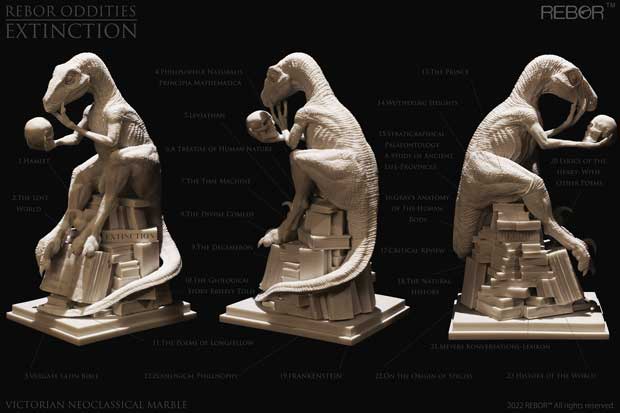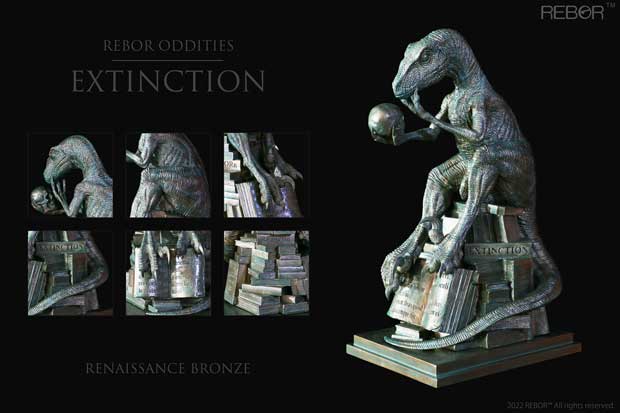The news that Rebor will introduce two new, highly innovative Velociraptor models into their Rebor Oddities range has certainly got tongues wagging. Team members have been busy responding to emails from customers about these figures over the last few days.

One recurring question has cropped up over and over again, customers have been keen to see a list of the books that the contemplative theropod is sitting on. As the Velociraptor considers the human skull that it is holding in its right hand, it is obviously a scholar, at least judging by the volumes contained in its library.

The Rebor “Extinction” Book List
In total, twenty-three books are featured in these intriguing sculpts. They are a combination of fiction and factual publications, each one, arguably representing a significant moment in the history of the written word.
Our list:
- Hamlet by William Shakespeare.
- The Lost World by Sir Arthur Conan Doyle first published in 1912.
- Vulgate Latin Bible – a 4th century translation of early Christian texts by Jerome of Stridon which was to become the official religious text adopted by the Catholic Church.
- Philosophiae Naturalis Principia Mathematica by Isaac Newton (later Sir Isaac Newton), published in 1687.
- Leviathan by Thomas Hobbes first published in 1651. Also known as “The Matter, Forme and Power of a Commonwealth Ecclesiasticall and Civil” it outlines a political philosophy whereby the population enter into a form of social contract with an absolute ruler.
- A Treatise of Human Nature by the Scottish philosopher David Hume, first published in 1739. The full title of this book is “A Treatise of Human Nature: Being an Attempt to Introduce the Experimental Method of Reasoning into Moral Subjects”.
- The Time Machine by H. G. Wells published in 1895.
- The Divine Comedy by the Italian poet Dante Alighieri published in the early 14th century.
- The Decameron by the 14th Century Italian writer Giovanni Boccaccio which recounts the stories told by a group of young people as they shelter from the Black Death.
- The Geological Story Briefly Told.
- The Poems of Longfellow – a compilation of the work of the American poet Henry W. Longfellow.
- Zoological Philosophy by Jean-Baptiste Lamarck first published in 1809 which outlined a theory of inherited characteristics passed on from generation to generation.
- The Prince published in the early 16th century by the Italian diplomat and politician Niccolò Machiavelli. It outlined the methods employed by people in power to keep their influential positions and justified the use of unethical and immoral means to achieve success.
- Wuthering Heights by Emily Brontë first published in 1847.
- Stratigraphical Palaeontology: A Study of Ancient Provinces.
- Gray’s Anatomy of the Human Body – after Henry Gray a comprehensive guide to human anatomy published in 1858.
- The Critical Review – published in the late 18th and early 19th centuries, a periodical that reviewed newly published books written by a diverse range of leading academics and public figures.
- The Natural History.
- Frankenstein by Mary Shelley written in 1818.
- Lyrics of the Heart: with Other Poems a collection of the work of the English poet and journalist Alaric Alexander Watts
- Meyers Konversations-Lexikon an encyclopaedia of the German language by Joseph Meyers.
- On the Origin of Species – the ground-breaking work by Charles Darwin (later Sir Charles Darwin) that outlines his theory of natural selection (first published in 1859).
- History of the World – possibly the six-volume history of the world in Hungarian published between 1906 and 1908 by Endrei Zalán.
Perhaps, the number twenty-three is also significant. In our species Homo sapiens, most of us have twenty-three pairs of chromosomes in our cells.

To view the range of Rebor models and figures currently in stock at Everything Dinosaur: Rebor Models and Figures.






Leave A Comment